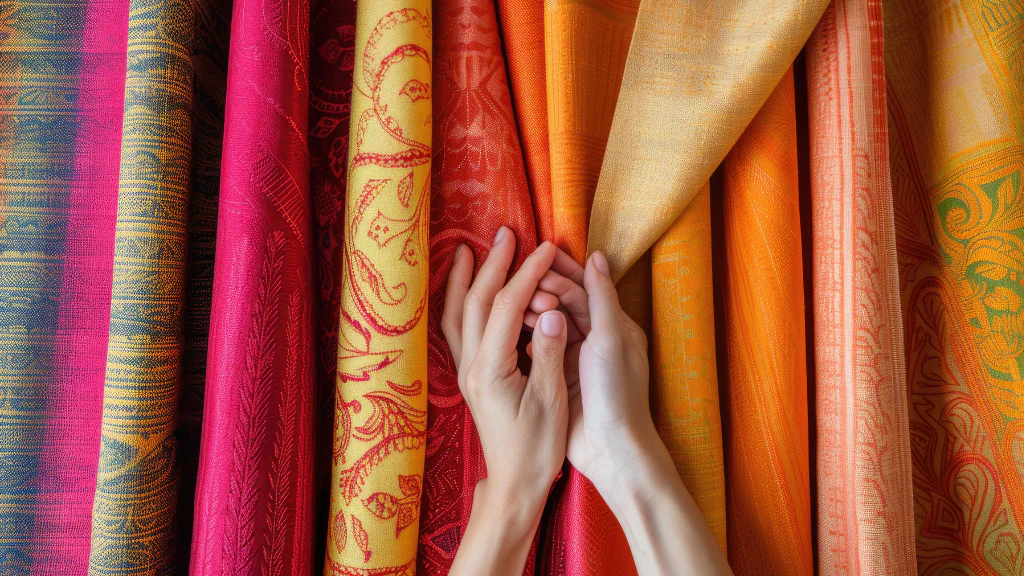A Guide to Indian Sarees: Types, Fabrics, and Styles
India is known for its diverse culture, rich heritage, and stunning attire, with sarees standing out as a timeless emblem of Indian tradition and elegance. Whether for weddings, festivals, or casual wear, sarees are loved for their grace and versatility.
In this guide, we’ll explore the popular types of Indian wholesaleethnics, their unique fabrics, and the distinct styles that make each region’s sarees so special.
1. Banarasi Saree: The Epitome of Elegance
Origin: Varanasi, Uttar Pradesh
Fabric: Silk
Style: Known for their intricate zari work and floral motifs, Banarasi sarees are typically worn at weddings and special occasions. With their luxurious silk fabric and gold or silver brocade, they bring a regal touch to any ensemble.
Pro Tip: Style your Banarasi saree with a classic choker necklace and matching earrings for a traditional look.
2. Kanjivaram Saree: The South Indian Marvel
Origin: Kanchipuram, Tamil Nadu
Fabric: Pure silk with golden zari
Style: Kanjivaram sarees are recognized for their bright colors, bold patterns, and high-quality silk. They often depict temple borders, checks, and intricate designs inspired by nature.
Pro Tip: A Kanjivaram saree paired with traditional gold jewelry creates an elegant, timeless look.
3. Chanderi Saree: The Perfect Blend of Silk and Cotton
Origin: Madhya Pradesh
Fabric: Silk, cotton, or a mix of both
Style: Lightweight and breathable, Chanderi sarees are known for their glossy transparency and exquisite motifs inspired by flora and fauna. They are an excellent choice for summer weddings or festive gatherings.
Pro Tip: Chanderi sarees look best with minimalist jewelry, allowing their subtle elegance to shine.
4. Bandhani Saree: The Colorful Tie-Dye Delight
Origin: Gujarat and Rajasthan
Fabric: Cotton, silk, or georgette
Style: Bandhani sarees showcase a vibrant tie-dye effect, made by tying small sections of the fabric and dyeing it. These wholesale party wear sarees are famous for their colorful patterns, including dots, waves, and checks.
Pro Tip: Style a Bandhani saree with oxidized jewelry to capture the vibrant spirit of Rajasthan and Gujarat.
5. Paithani Saree: Maharashtra’s Pride
Origin: Maharashtra
Fabric: Silk with metallic zari
Style: Paithani sarees are known for their luxurious silk, peacock motifs, and stunning pallu designs. The intricate weave and vibrant colors make them a popular choice for traditional Maharashtrian weddings.
Pro Tip: Accessorize a Paithani saree with a nath (nose ring) and green glass bangles for an authentic Maharashtrian look.
6. Kerala Kasavu Saree: The Simple and Graceful White Saree
Origin: Kerala
Fabric: Cotton with gold zari borders
Style: Kasavu sarees are recognized by their off-white color with gold borders, representing purity and simplicity. Worn during festivals like Onam, they reflect the elegance of Kerala’s cultural attire.
Pro Tip: A Kasavu saree looks stunning with temple jewelry and fresh jasmine flowers in the hair.
7. Sambalpuri Saree: A Unique Weave from Odisha
Origin: Odisha
Fabric: Cotton or silk
Style: Known for their traditional ikat weaving, Sambalpuri sarees feature unique patterns and motifs such as flowers, wheels, and shells. They are highly durable and symbolize Odisha’s textile heritage.
Pro Tip: Sambalpuri sarees are perfect for casual and formal occasions and look stunning with silver jewelry.
8. Assam Silk Saree: The Jewel of the Northeast
Origin: Assam
Fabric: Muga silk, known for its durability and golden sheen
Style: Assam silk sarees are prized for their natural sheen and lightweight texture. The traditional motifs include peacocks, flowers, and geometric patterns, making them suitable for festive occasions.
Pro Tip: Pair an Assam silk saree with pearl jewelry for an elegant and sophisticated look
9. Patola Saree: The Double Ikat Wonder
Origin: Patan, Gujarat
Fabric: Silk
Style: Patola sarees use a unique double ikat weaving technique that makes the fabric durable and vibrant. These sarees often feature intricate motifs like elephants, flowers, and parrots.
Pro Tip: Patola sarees are striking and don’t need heavy jewelry – keep it simple to let the saree shine.
10. Net Saree: A Modern Twist on Tradition
Origin: Various regions in India
Fabric: Net or tulle with embellishments
Style: Net sarees are popular for their lightweight feel and modern appeal, often embellished with sequins, beads, or embroidery. Perfect for parties or cocktail events, they bring a glamorous edge to the traditional saree.
Pro Tip: Style a net saree with a sleek blouse and bold statement jewelry to turn heads at any event.
Choosing the Right Fabric for Every Occasion
Different fabrics add unique qualities to sarees, making each ideal for specific occasions:
- Silk Sarees: Perfect for weddings and festivals.
- Cotton Sarees: Great for daily wear or casual events, especially in warmer climates.
- Georgette and Chiffon Sarees: Lightweight and ideal for parties and gatherings.
- Net Sarees: Best for evening events or cocktail parties.
- Banarasi and Kanjivaram Sarees: Ideal for bridal wear due to their rich look and intricate designs.
How to Style Your Saree
Styling a saree goes beyond just the drape; accessories, hairstyle, and makeup all play a crucial role. Here are some quick styling tips:
- Jewelry: Match the style and region of the saree with the jewelry. For instance, a Banarasi saree pairs beautifully with Kundan jewelry, while silver jewelry complements handloom sarees.
- Blouse Design: Experiment with blouse designs such as backless, boat neck, or full-sleeve to add a modern twist.
- Footwear: Go for comfortable, low-heeled sandals or mojris that match the saree’s fabric and occasion.
Conclusion
The world of Indian sarees is as vast and varied as India itself. Each saree type has its own story, fabric, and style that reflect the region it comes from. Whether you’re a saree enthusiast or just beginning to explore this beautiful attire, knowing the types and fabrics will help you make the right choice for any occasion. Embrace the elegance and diversity of Indian sarees, and let your attire tell a story of timeless grace and tradition.














Post Comment